ISSN ONLINE(2319-8753)PRINT(2347-6710)
ISSN ONLINE(2319-8753)PRINT(2347-6710)
Mr. Mahesh Gavali1, Mr.Satish Kulkarni 2
|
| Related article at Pubmed, Scholar Google |
Visit for more related articles at International Journal of Innovative Research in Science, Engineering and Technology
Comparative study for portable weeders and power tillers in the Indian market is discussed. Various methods used for weed removal in crops are also discussed. Main focus of this is to study various equipment’s used for mechanical weed removal. This study revealed that most of the Indian farmers, majority of which are small scale farmers can afford only portable weeders. These small scale farmers as such don’t use mechanical weed control methods. Chemical and manual weeding is predominantly used by these small scale farmers. The literature survey indicated that portable weeders are relatively less expensive in operation and maintenance but are also less versatile. Power tillers are considerably more expensive but are also very much more versatile and can operate in variable soil conditions. Due to these constraints most smaller farmers resort to chemical and manual weeding. These methods are labor intensive and as such a major constraint in crop production. Research has been carried out in many countries to involve technologies such as image analysis, GPS navigation, etc. in mechanical weeding machines. But most these efforts are yet to leave a lasting effect in market place. Hence it is necessary to develop more efficient and cost effective methods of mechanical weeding so as to lessen the use of chemical and manual weed removal methods
Keywords |
| weeds, weeding, portable weeders, power tillers. |
INTRODUCTION |
| Agriculture is the backbone of Indian economy. India being developing nation agriculture and industries based on agriculture products has prime importance in the national economy. Majority of the Indian population depends on agriculture and agro-based industries and businesses. Lack of mechanization or automation is one of the major roadblocks to improving the productivity of agriculture. One of the major reasons for lack agricultural productivity is weeds. Weed is an everyday term usually to describe a plant considered undesirable. The word weed is commonly applied to unwanted plants in human-controlled settings, such as farm fields, gardens, lawns, and parks. Weeds compete with the beneficial and desired vegetation in crop lands, forests, aquatic systems etc. and poses great problem in non-cropped areas like industrial sites, road/rail lines, air fields, landscape plantings, water tanks and water ways etc. Weeds are an important factor in the management of all land and water resources, but its effect is greatest on agriculture. The losses caused by weeds exceed the losses caused by any other category of agricultural pests. Weeds may be unwanted for a number of reasons. An important one is that they interfere with food and fiber production in agriculture, wherein they must be controlled in order to prevent lost or diminished crop yields. Other important reasons are that they interfere with other cosmetic, decorative, or recreational goals, such as in lawns, landscape architecture, playing fields, and golf courses. Similarly, they can be of concern for environmental reasons whereby introduced species out-compete for resources or space with desired plants. Weeds have long been a concern, perhaps as long as humans have cultivated plants. |
LITERATURE REVIEW |
| Weed removal is one of the major activities in agriculture. Chemical method of weed control is more prominent than manual and mechanical methods. However, its adverse effects on the environment are making farmers to consider and accept mechanical methods of weed control. Chemical weeding is the most extensively used method of weed removal [12]. But these chemicals used for weeding are harmful to living organisms and toxic in nature. Research has been carried out to use some combination various methods of weeding. The need of replace the use of herbicides with more sustainable weed control techniques encouraged the definition of innovative physical weed control strategies. Mechanical and thermal means were used to control weeds [5]. Weed removal by mechanical method is one the methods frequently used these to remove weeds from the agricultural fields. Research has been conducted on economical method s for weed removal without damaging the crops. Weeding Machines designed and developed with intent of being operated in specific crops like tomatoes, corn, and rice. These machines are mostly intra row weeding machines which remove weeds within multiple crop rows at once [1] [2] [3] [4]. Weeding machines like three row walking type one were developed and successfully to remove weeds from rice [4]. |
| Sensors like laser sensors are used some machines to differentiate the weeds from crops and increase the effectiveness of weeding. Various plant-recognizing systems like light interceptors, vision based systems are being researched for intra-row weeding [1] [6] [7] [8]. Some of these machines even use advanced algorithms to indentify the various types of weeds [1]. Number of novel techniques like GPS, RTK (real time kinematics) was incorporated into weeding machines to control and operate the machine [9] [2] [10]. The rate and effectiveness of weed removal depends on number of parameters related to machine performance parameters and soil properties such as types of cutting blades used, machine efficiency, moisture content, etc. Studies have been conducted on the effect of moisture content and the type of cutting blades like flat blades, spike tooth blades and curved blades on the performance of weeding machines [13]. Mechanical weeding was found to be less effective when soils are wet during or after the weeding operation [13] [14]. |
WEED CONTROL METHODS |
| The removal and eradication of weeds from the fields, gardens or land with minimum damage to the desired plants is weed control. Various methods described below are used for removal of weeds from desired plants. |
| A. CHEMICAL WEEDING |
| Chemical control involves the use of herbicides. Herbicides control weed plants either by speeding up, stopping or changing the plant's normal growth patterns; by drying out the leaves or stems; or by making it drop its leaves. Chemical Control with herbicide application can provide the most effective and time-efficient method of managing weeds. Numerous herbicides are available that provide effective weed control and are selective in that grasses are not injured. Weed removal is one of the major activities in agriculture. Chemical method of weed control is more prominent than manual and mechanical methods. However, its adverse effects on the environment are making farmers to consider and accept mechanical methods of weed control. Chemical weeding is the most extensively used method of weed removal [12]. But these chemicals used for weeding are harmful to living organisms and toxic in nature. |
| B. MECHANICAL WEEDING |
| Mechanical control is the use of powered tools and machinery to manage weeds. It is suitable for larger infestations because it reduces the weed bulk with less manual effort. Mechanical control consists of methods that kill or suppress weeds through physical disruption. Such methods include pulling, digging, disking, plowing and mowing. |
| C. BIOLOGICAL WEEDING |
| Biological control involves the use of insects or pathogens that affect the health of the weed. It includes the use of living organisms for suppressing or controlling the weeds. Plant, animal or micro organisms may be used for destruction of weeds. The goal of biological control is not eradication, but the use of living agents to suppress vigor and spread of weeds. Such agents can be insects, bacteria, fungi, or grazing animals such as sheep, goats, cattle or horses. Grazing produces results similar to mowing, and bacteria and fungi are seldom available for noxious weed management. Biological control is most commonly thought of as 'insect bio control'. |
| D. MANUAL WEEDING |
| Manual control is the use of the hands or handheld tools to deal with weeds. Extensive amount of cheap manual labor is necessary for manual weeding. Manual weeding is commonly employed by smaller Indian framers for weed removal. |
MECHANICAL WEEDING |
| In developed countries like, USA, European Union Countries, Australia and Israel large emphasis has been placed on mechanization of the various agricultural processes. For this number of machines have been developed and successfully implemented. Use of such machines in the Indian Agricultural Scenario is difficult as most the Indian farmers are small scale farmers as area under their control is small. Mechanical weeders range from basic hand tools to sophisticated tractor driven or self-propelled devices. These may include cultivating tools such as hoes, harrows, tines and brush weeders, cutting tools like mowers, as well as implements like thistle-bars that may do both. Two wheeled pedestrian or walking tractors are a smaller alternative that can power a similar range of implements. Most machines large in size not affordable for medium and small scale farmers. Weed removal by mechanical method is one the methods frequently used these to remove weeds from the agricultural fields. Research has been conducted on economical methods for weed removal without damaging the crops. Weeding Machines designed and developed with intent of being operated in specific crops like tomatoes, corn, and rice. These machines are mostly intra row weeding machines which remove weeds within multiple crop rows at once [1] [2] [3] [4]. Weeding machines like three row walking type one were developed and successfully to remove weeds from rice [4]. Sensors like laser sensors are used some machines to differentiate the weeds from crops and increase the effectiveness of weeding. Various plant-recognizing systems like light interceptors, vision based systems are being researched for intra-row weeding [1] [6] [7] [8]. Some of these machines even use advanced algorithms to identify the various types of weeds [1]. Number of novel techniques like GPS, RTK (real time kinematics) was incorporated into weeding machines to control and operate the machine [9] [2] [10]. The rate and effectiveness of weed removal depends on number of parameters related to machine performance parameters and soil properties such as types of cutting blades used, machine efficiency, moisture content, etc. Studies have been conducted on the effect of moisture content and the type of cutting blades like flat blades, spike tooth blades and curved blades on the performance of weeding machines [13]. Mechanical weeding was found to be less effective when soils are wet during or after the weeding operation [13] [14]. Weeding operation in India performed mostly by using tilling attachments available for tractors. These attachments though can only be used before sowing. These tillers are not used solely for the purpose weed removal. Power tillers of various types and sizes are also available in the Indian market. These tillers are used by some medium and large scale farmers for the weed removal. Most the designs of such equipment’s are meant for general purpose use and as such cannot be for inter-row weed removal between two rows of crop. |
| Machines meant solely for the purpose of weed removal are not easily available in India. Although some agricultural manufacturers are making efforts and made certain equipment available which are mainly intended for weed removal in farms. These machines are again primarily intended for use before sowing and when are small. These machines are also quite costly and operate on diesel or petrol powered engines. Inter-row weeders are also available which remove weeds from multiple rows of crops at once. Operational cost of these is lower than other available equipment but even these machines can only be used for weed removal when crops are small. With most mechanical weeding implements, operator skill, experience and knowledge are critical to success. Drawbacks to mechanical weed control include low work rates, delays due to wet conditions, and the subsequent risk of weed control failure as weeds become larger Hence it is important to develop machines and implements which can perform mechanical weeding in an efficient and cost effective manner to represent a viable alternative. |
DETAILED SURVEY OF DIFFERENT PORTABLE WEEDERS AND TILLERS IN THE INDIAN MARKET |
| The weeding machinery available in the Indian market can be divided into two different categories portable weeders and power tillers. Of the above mentioned two categories portable weeding machines hard to find in market and rarely used by farmers. Power tillers are sometimes used by large scale land farmers because of their versatility. Most small and medium scale farmers, which account for nearly 93% of the total number of farmers in India; cannot afford these power tillers due to their high initial and operating costs. Separate literature survey and analysis is to be conducted for portable weeders and then power tillers. |
| A. PORTABLE WEEDERS |
| Portable weeders are generally smaller machines which solely intended to be used for weeding operations only. These machines are generally easy to operate and do not require any type of prior training for safe operation. These weeders are usually powered by small two stroke engines. The power by engines is used solely for rotating the blades located at the front of the machine. These weeders usually compromise of engine, frame, support wheels and blades. Some of the manufacturers, models along with their attributes are tabulated below. |
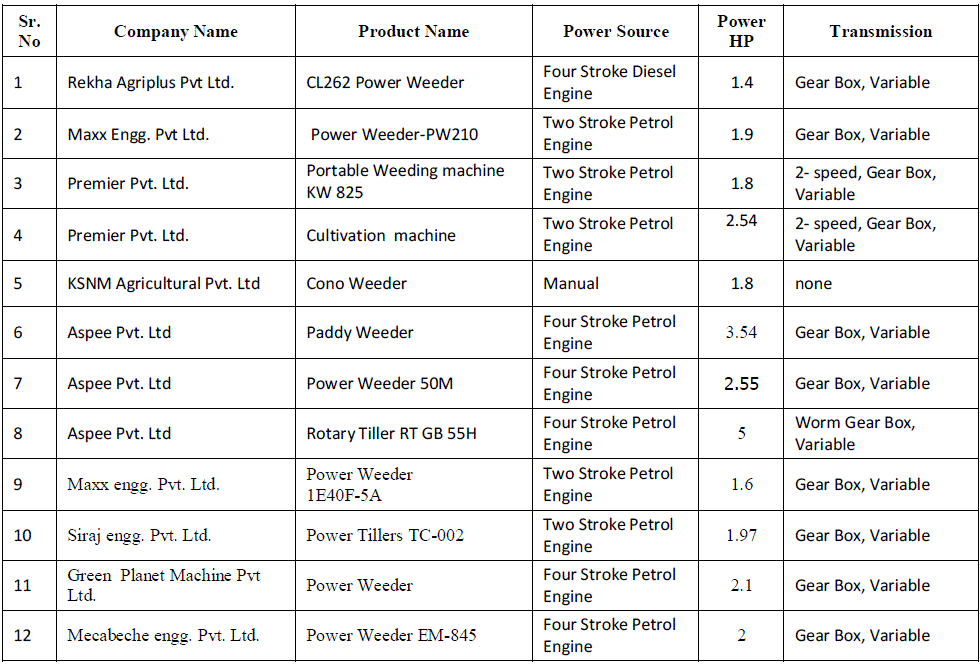 |
| These weeders use recoiled starters for starting the engines. The forward motion to the machine is generally provided pushing the machine forward manually. The engine power in most cases is used solely for rotating the blades of the tool. The engine power is transmitted from the engine to the blades through a shaft, mechanical clutch and gearbox. Although in some cases where larger speed reduction is required chain drive or belt drives or worm gears are used. The gearbox used are reduction type and 2-speed gearbox or 4-speed gearbox are preferred. Parameters such as weight of the machine, weeding width, area of application, etc. are detailed in comparative analysis table no. 1. The power generated and required by portable weeders is low and it ranges from 1.5 HP to 5 HP. The engine capacity for two stroke engines is about 25cc to 50 cc in most cases. Fuel consumption is about 60 min/ lit to 80 min/lit. |
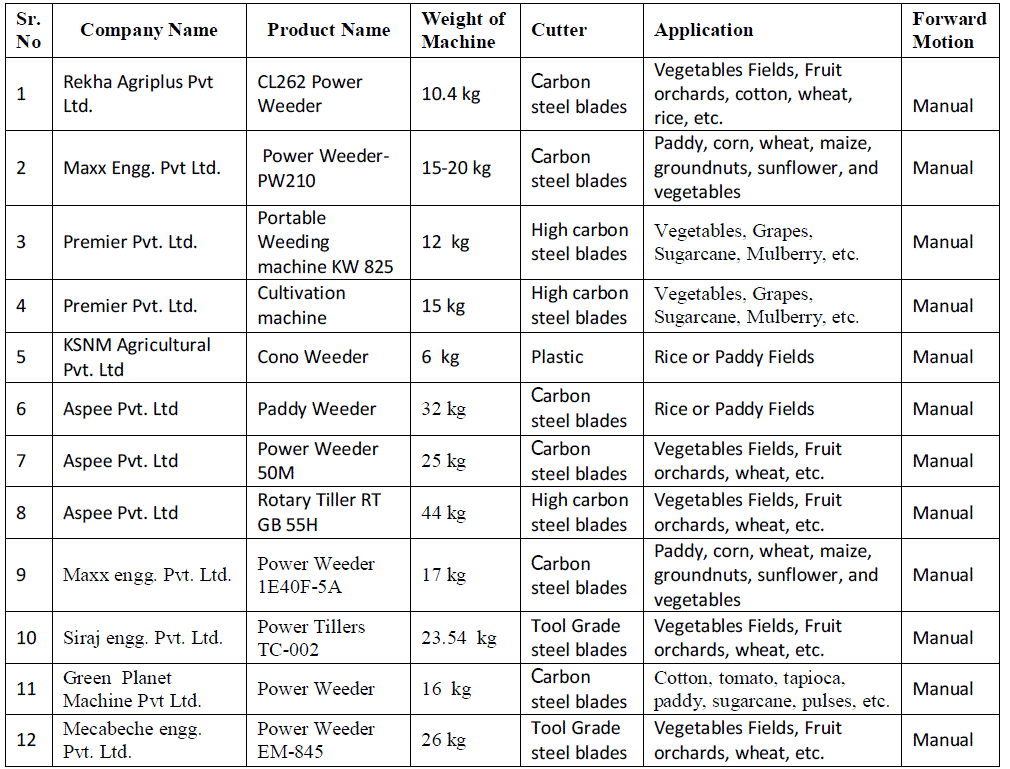 |
| Weight of these portable weeders is low and it ranges from 10 kg to 40 kg. Weight of these is deliberately kept low as they are moved and maneuvered manually. The weeding width ranges from 25 cm to 80 cm. Weeding or tilling width depends the crops being and number of rows being weeded at once. Most of these portable weeders weed one row at a time. The weeding width is adjustable in some weeders like Rekha Agriplus Pvt Ltd. Power Weeder CL262.The width and in some cases depth depends upon the design of blades and the number of blades provided. The weeding depth is around 15 cm for most of these machines. Blades used in these portable weeders are consists of solid hub around 80 cm to 100 cm in outer diameter on to which curved metal strips (blades) are attached by riveting or welding. The material used for manufacture of these blades is carbon steel, although in some aluminum alloys, plastics are used. Some of these machines like Rekha Agriplus Pvt Ltd. Power Weeder CL262 work with different number of blades with different sizes and width based on the weeding capacity required. The torque required and produced by these portable weeders is quite low as compared to power tillers. For ex Aspee Pvt. Ltd. Power Weeder 50M produces about 2.74 Nm@ 5000 rpm. Similar figures are produced by other portable weeders at comparable speeds. Weed removal rate of most these weeders are comparable and slightly faster than manual weeding. But these weed removal rates are slower than power tillers as well as chemical weeding. |
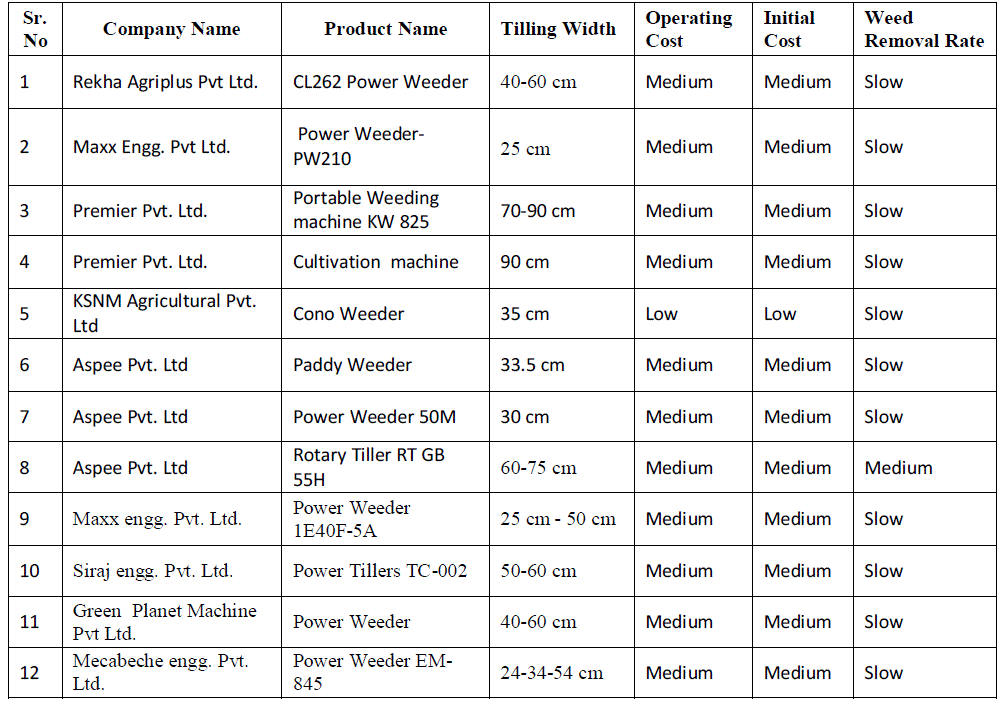 |
| These portable weeders are designed to the used tin specific areas like paddy fields, fruit orchards, cotton, wheat, grapes, groundnut, sunflower fields, etc. The initial cost of these machines is quite low as compared to power tillers as these contain less nos. of working components and weight of these machines is low. Retail price of portable weeders ranges from 15,000 to 40,000 Rs/-. The operating cost of these machines is quite low as compared to power tillers. Operating cost is higher than chemical weeding. The price of fuel used (petrol) is rising steadily and constantly in recent times. Thus it necessary to find viable alternatives to petrol engine as power source for these machines in order to reduce operating cost. Renewable energy sources like, solar power and electricity provide excellent alternatives here. |
| B. POWER TILLERS |
| Power tillers are larger machines used for multiple numbers of agricultural operations. Some of the commonly performed operations by power tillers are: |
| a) Weeding for crops like sugarcane, cotton, vegetables, fruit orchards, grapes, etc. |
| b) Forming ridges and furrows |
| c) Earthing up or loosening the soil for aeration. |
| d) Spraying pesticides, fungicides, etc. |
| e) Fertilizer mixing and application. |
| Weed Removal is one the major operations performed by power tillers. These machines are being used by some large scale farmers to perform above mentioned activities. Initial and operating costs of these machines considerably higher than portable weeders and as such these machines are not affordable for most of the Indian farmers. Retail price of power tillers is usually in lakhs of rupees. Running cost are also high as these machines are powered forward by engine power itself. Weight of these machines is also on the higher side. Power tillers in the Indian Market are available from both Indian Manufacturers as well as foreign ones. Some of the manufacturers, models along with their attributes are tabulated below. |
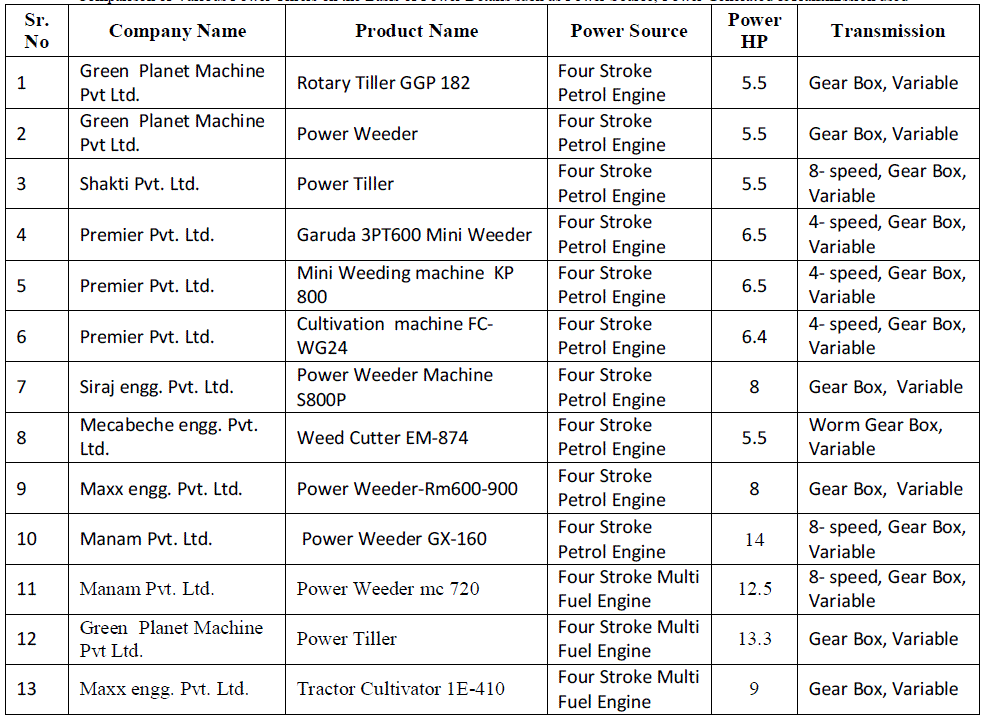 |
| Power tillers are easily available in the Indian market place. Power source for the tillers are usually four stroke petrol or diesel engines. The power capacity ranges from 5 HP to 15 HP. Power transmission system consists of 4- speed to 8- speed gearbox with a mechanical clutch. The support wheels are located at middle machine. These wheels are usually centrally driven. The size of these wheels is also large to support the weight of the machine and operator. |
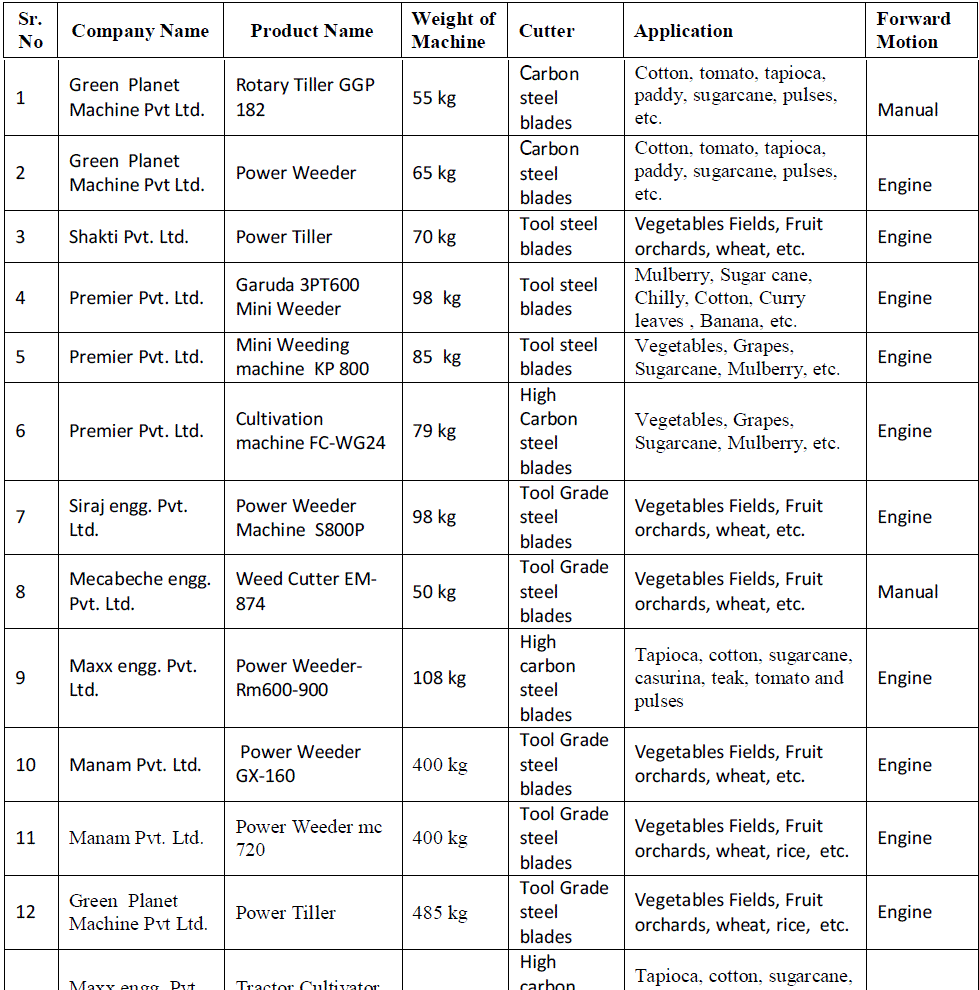 |
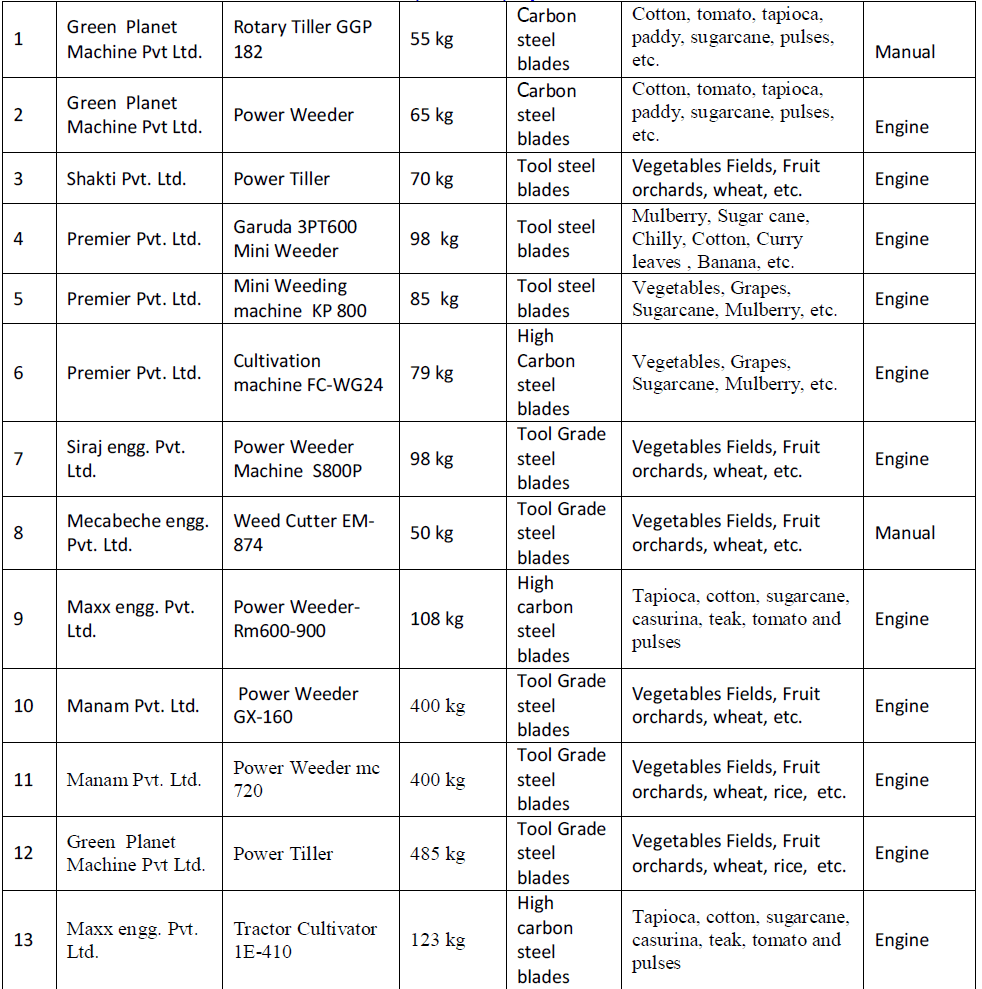 |
| Some of these power tillers can weigh as high as 500 kg. Power tillers as such based on above discussion are not as relevant as portable weeders while designing our weed removal machine WRM. But certain aspects of these tillers must be kept in mind before proceeding design the weed removal machine. Aspects like area of application, weed removal rate, materials used, tilling width & depth are important. |
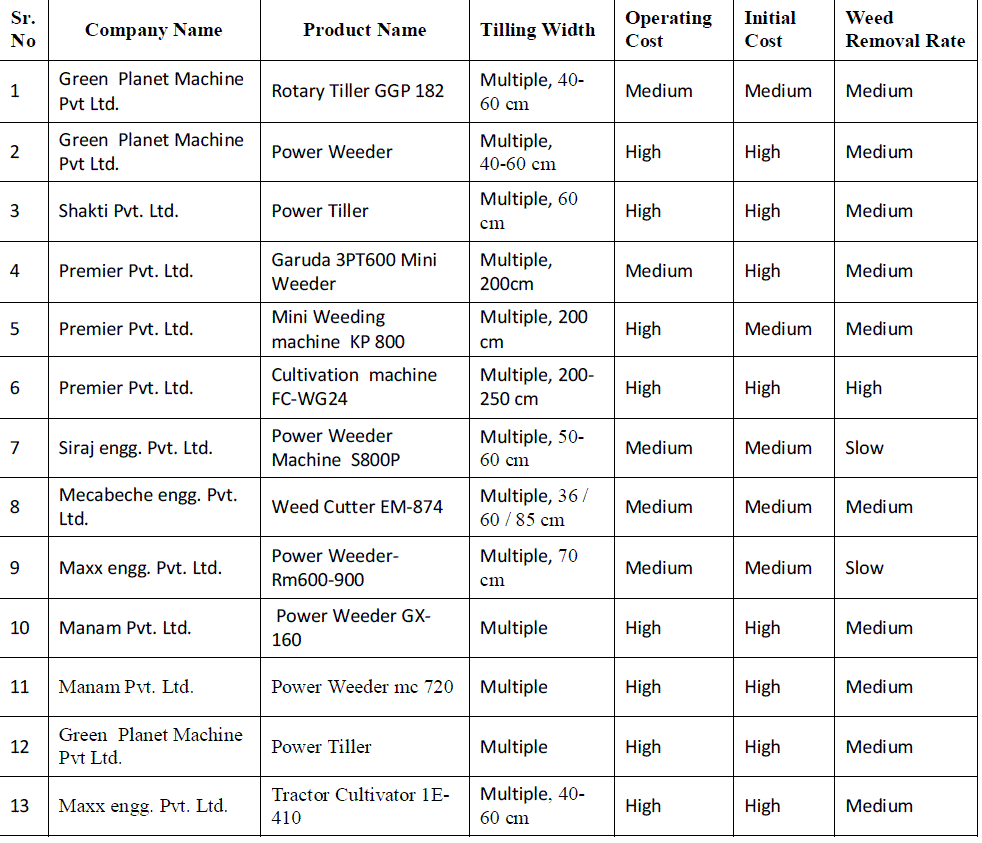 |
| Power tillers are versatile and same machine can be used in variety of crops from paddy fields to fruit orchards. Weed removal rate of these machines is quite high due to faster speed of operation. Usually high quality material is used for the construction of these machines. Blades are mostly made from high carbon steel or tool steel. These are used for weeding multiple rows at once. The tilling width for power tillers ranges from 60 cm to 250 cm and this width can varied as per the requirement. The tilling depth for these machines can be as high as 30 cm for larger machines. |
CONCLUSIONS |
| 1. Portable weeders are available in various ranges in Indian market. The power rating of these weeders is from 1.5 HP to 5HP majority of them is petrol powered for cutters and manual movement in field. Weights of these are between 10.4 kg to 44 kg as they needed to be driven manually. The weed removal rate is obliviously low. They have low initial cost ranging between Rs. 15000/- to Rs. 40000 and operating cost largely depends on cost and consumption of petrol and manual labor required for operation. |
| 2. Power tillers are useful for large area of cultivated lands may be beyond 5 hectors. The investment is very high compared to portable weeders. The power tillers are available in variable width unlike portable weeders. The initial investment and running cost they are mainly operated by professional and farmers use them on rent. However they are not cost effective for small farmers. |
| 3. In the Indian agricultural scenario 62 % people hold land below 1 ha covering 18 % of the total area cultivated. 44% of the area of land is divided in pieces of 1ha to 4ha. Only 1% people hold land above 10ha with area covered is approximately 13%. Hence the power tillers are not suitable for Indian scenario. Power tillers are used by many farmers in medium land holding. At lower end with very low land holding farmers use manual weeding methods over any mechanization. Further recent advancement in technologies such as GPS, image analysis is yet to be incorporated into any of the machines available in the market. By integrating these technologies efficiency, productivity and weed removal rate can be increased and crop damage can be reduced. |
| 4. It is hence become necessary to develop a cost effective solution for weeders useful in variety of soil, which can be used by farmers in low and medium holding of land and increase the productivity and yield of the crop. Authors have finalized the design requirements and design and optimization is in process. |
References |
|